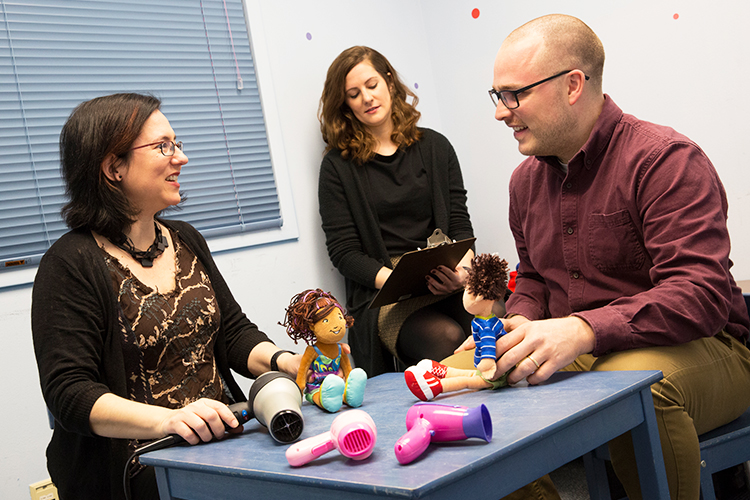
A dose of humor for treating fears
When children have significant difficulty reducing their fears and anxieties, the solution can be a surprisingly natural one: play, humor and silliness.
A team of UWM students is exploring that approach for children with Williams syndrome, a genetic disorder that affects some 30,000 children in the United States. They’re working under the guidance of clinical psychology professor Bonnie Klein-Tasman using the facilities and assorted toys in UWM’s Child Neurodevelopment Research Lab.
Children with Williams syndrome can struggle with anxieties and fears more often than most kids. Many are hypersocial, displaying an unusually affectionate behavior with intense eye contact. Other concerns include cardiovascular problems, hyperactivity and learning disabilities, though their strong interest in interacting with others and good verbal skills often mask significant developmental delay.
“Kids with Williams syndrome receive special education services in school for their cognitive deficits and hyperactivity symptoms,” says clinical psychology graduate student Brianna Yund, “but many families struggle with the impact of the phobias on daily life, and few clinicians are trained in treating anxieties in children with intellectual disabilities. Our study is intended to fill that gap.” The team hopes the results could be applicable beyond Williams syndrome cases, too.

A behavioral play therapy for reducing their phobias has already been developed, but it lacks a detailed how-to manual. Klein-Tasman’s team will create that manual and share it with practitioners through a web portal, allowing for a systematic evaluation of the intervention’s success.
A traditional strategy for treating phobias – say, of loud noises or receiving shots at the doctor’s office – involves gradually increasing levels of exposure to the object of fear. But this exposure therapy often causes discomfort, which is why many parents of young children don’t embrace it.
“Behavioral play therapy combines exposure therapy with humor in a playful setting,” says graduate student Nathanael Schwarz. An intervention for hair-combing anxiety may start with pretend play: The therapist combs a doll, then exaggerates the brushing movements and makes silly noises while chasing the doll around the room. Next, the therapist may comb her own hair, and eventually the child’s. But if that generates signs of distress, the therapist backs up to less aversive behavior until the child is comfortable again, and perhaps silly herself.
“Anecdotal evidence suggests that kids respond very well to this approach because they love to be silly,” Schwarz says. “With the larger amount of data we will now collect, we can evaluate this intervention more systematically.”
Yund and Schwarz have a central role in researching and evaluating the new therapy and will assist Klein-Tasman and UWM graduate EJ Miecielica in developing the manual. The Williams Syndrome Association is funding the study through a grant and will assist with the recruitment of eight children, ages 4 to 10, who will be treated at UWM in 2018. The association will also help disseminate the new manual.
“Very few studies have evaluated interventions for anxiety in young children with developmental disabilities,” Klein-Tasman says. “That’s why we hope our work will also inform the treatment of phobias in children with other conditions, such as autism spectrum disorders.”